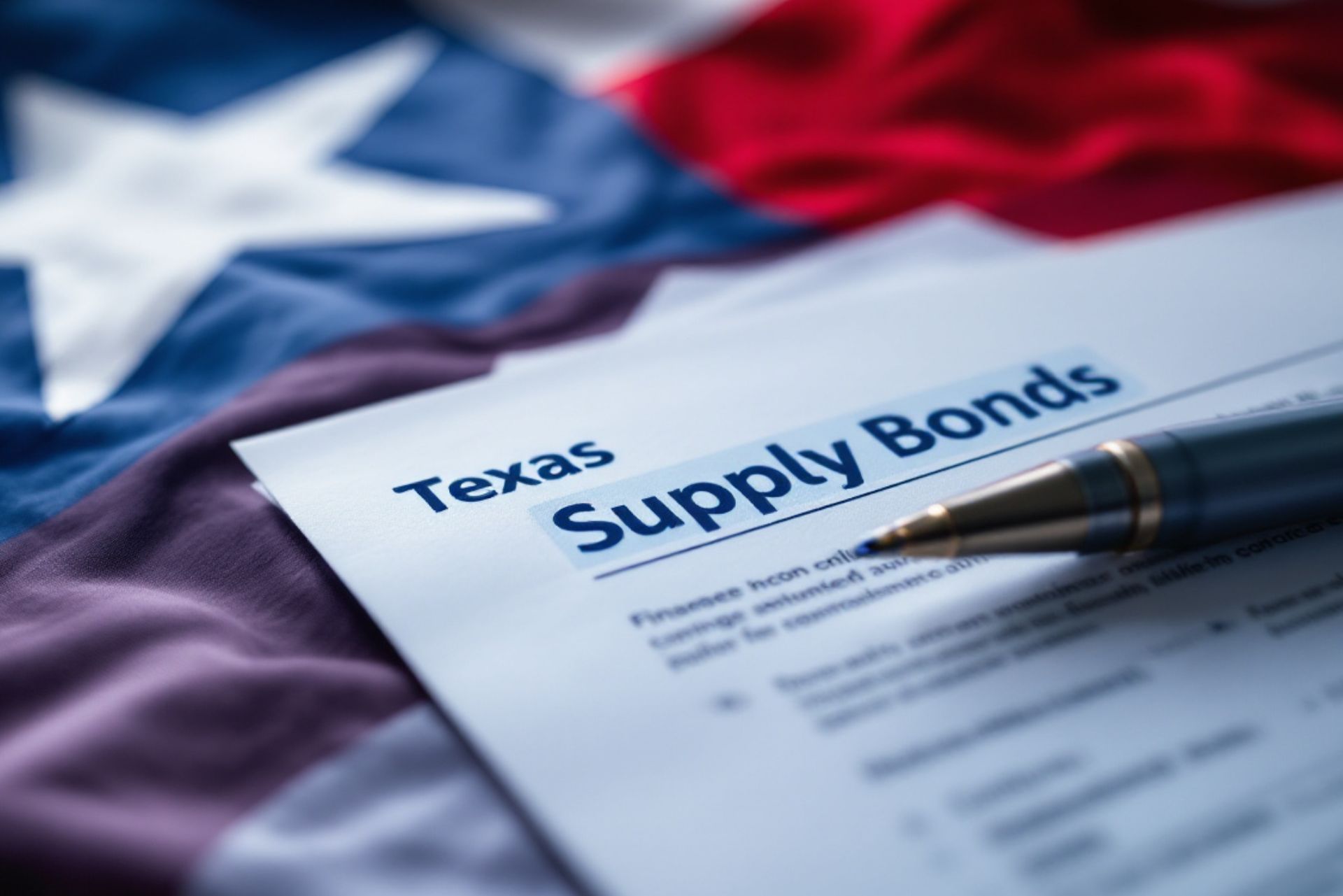
We're an independent insurance agency in Texas
Our experienced team offers services for both residential and commercial properties.With over 25 years of experience in the industry.
Contact Us
6600 Lyndon B Johnson Fwy Ste 220, Dallas, TX 75240, United States
(214) 253-0570
quotes@thephoenixinsurance.com
Working Hrs : 9.30am to 5.30pm

Most Common Business Policies
Index
Contact Us
Texas supply bonds are an integral part of the state's financial framework, designed to facilitate funding for various public projects. This guide will explore the ins and outs of Texas supply bonds, providing essential information for investors, bondholders, and anyone interested in understanding this aspect of the economic landscape.
Understanding Texas Supply Bonds
Texas supply bonds serve as a tool for raising capital that state and local governments require for infrastructure improvements, public services, and other projects. These bonds are essentially loans from investors to the government, which promises to repay these loans with interest over a specified period.
Definition and Purpose of Supply Bonds
Supply bonds can be defined as a financial instrument issued by municipal authorities to secure funding for various projects. Their primary purpose is to generate revenue that supports initiatives in transportation, education, healthcare, and other critical sectors.
Investors who purchase these bonds are typically institutions, corporations, or individuals looking for stable investment options. The funds raised through these bonds allow the state to undertake projects that might otherwise be difficult to finance through traditional means. This mechanism not only provides the necessary capital but also fosters a sense of community investment, as residents can see their contributions directly impacting local development.
The Role of Supply Bonds in Texas Economy
The role of supply bonds in Texas’s economy cannot be overstated. They are essential for maintaining and improving infrastructure, which is crucial for economic growth. By providing the necessary funding for roads, schools, and hospitals, these bonds help create an environment conducive to economic development.
Moreover, Texas supply bonds have a multiplier effect on the economy. When projects funded by these bonds are completed, they create jobs and stimulate local economies, leading to increased tax revenues and improved public services. For instance, the construction of new highways not only enhances transportation efficiency but also attracts businesses that rely on robust logistics networks. Additionally, investments in educational facilities lead to a more skilled workforce, further driving economic prosperity.
Furthermore, the issuance of supply bonds can often be seen as a reflection of the state's commitment to its citizens. By prioritizing funding for essential services and infrastructure, Texas demonstrates its dedication to improving the quality of life for its residents. This proactive approach not only fosters community trust but also encourages further investment from both public and private sectors, creating a cycle of growth and development that benefits all Texans.

The Process of Acquiring Texas Supply Bonds
Acquiring Texas supply bonds is a structured process that involves several steps. Understanding this process is vital for potential investors looking to participate in the bond market.
Eligibility Criteria for Supply Bonds
Before investing in Texas supply bonds, one must meet specific eligibility criteria. Generally, these bonds are available to accredited investors, which include institutions and individuals with a substantial net worth or income.
Furthermore, potential investors should have a basic understanding of municipal finance and the specific projects these bonds are funding. Some bonds may have specific requirements, such as minimum investment amounts or particular purchase processes. It is also important to note that certain bonds may be designated for specific uses, such as infrastructure improvements or public services, which can influence both their risk profile and potential returns.
Step-by-step Guide to Acquiring Supply Bonds
- Research the Market: Understand the different types of supply bonds available and identify which projects you are interested in funding.
- Consult Financial Advisors: Speak with financial professionals who can provide expert advice tailored to your financial situation.
- Review Bond Offerings: Look at official disclosures and offering documents to assess the risks and yields associated with the bonds.
- Make Investments: Once you have gathered sufficient information and made decisions, you can proceed to acquire bonds through brokers or directly from issuers.
By following these steps, investors can navigate the complexities of purchasing Texas supply bonds more successfully. Additionally, it is beneficial to stay informed about market trends and economic indicators that may affect bond performance. For example, changes in interest rates, inflation expectations, or state budget allocations can all influence the attractiveness of specific bonds. Engaging with local financial news and attending investment seminars can provide valuable insights that enhance your investment strategy.
Moreover, understanding the tax implications of Texas supply bonds is crucial. Many municipal bonds offer tax-exempt interest, which can be a significant advantage for investors in higher tax brackets. However, it is essential to consult with a tax professional to understand how these investments fit into your overall tax strategy. This knowledge can help you maximize your returns and ensure compliance with tax regulations, ultimately leading to a more informed and strategic investment approach.
Key Features of Texas Supply Bonds
Understanding the key features of Texas supply bonds is essential for making informed investment decisions. These features can significantly influence your investment strategy and overall financial goals.
Interest Rates and Terms
Texas supply bonds typically have fixed interest rates that are set at the time of issuance. These rates can vary widely based on market conditions, the creditworthiness of the issuing authority, and prevailing economic factors.
The terms of these bonds can range from short-term to long-term, providing flexibility for investors. Short-term bonds are often used for projects requiring immediate funding, while long-term bonds are ideal for financing larger initiatives with prolonged benefits. Additionally, the duration of the bond can impact its yield; generally, longer maturities may offer higher interest rates to compensate for the increased risk over time. Investors should also consider the timing of their cash flow needs when selecting the appropriate term for their bond investments.
Risks and Benefits
Like any investment, Texas supply bonds come with both risks and benefits. One of the primary benefits is the relative safety they provide compared to riskier investments, especially if issued by creditworthy municipalities.
However, risks include interest rate risk, credit risk, and market risk. Changes in interest rates can affect the bond’s market value, while credit risks arise if the issuing entity struggles to meet its payment obligations. It’s crucial for investors to weigh these risks against the potential benefits. Moreover, investors should stay informed about the economic environment and any legislative changes that could impact the financial health of the issuing authorities. Understanding the local economic conditions, such as population growth and infrastructure development, can also provide insights into the potential success of the projects funded by these bonds, ultimately influencing their investment outcomes.
Legal Aspects of Texas Supply Bonds
The legal framework surrounding Texas supply bonds is critical to ensuring transparency and protecting investor interests. Understanding these regulations is paramount for anyone involved in the bond market.
Regulatory Framework for Supply Bonds
Texas supply bonds are governed by state and federal laws, which outline how they can be issued and managed. The Texas Bond Review Board plays a significant role in overseeing the issuance of municipal bonds to ensure compliance with regulations and ethical standards. This oversight is essential to maintain investor confidence and to facilitate the smooth operation of the bond market. Additionally, the board conducts regular reviews and audits to ensure that all transactions adhere to established guidelines, thereby minimizing the risk of fraud and mismanagement.
Investors should familiarize themselves with relevant laws, such as the Texas Public Finance Authority Act, to understand their rights and obligations concerning these bonds. This act not only sets the framework for bond issuance but also provides mechanisms for dispute resolution, which can be crucial in times of financial distress. Understanding these legal provisions can empower investors, enabling them to navigate the complexities of the bond market with greater assurance.
Rights and Responsibilities of Bondholders
Bondholders have specific rights, including the right to receive principal and interest payments as agreed upon. In the event of default, bondholders may have recourse to the issuer’s assets or obligations, depending on the bond structure. This aspect of bondholder rights underscores the importance of due diligence before investing, as the security of an investment can vary significantly based on the financial health of the issuer and the specific terms of the bond.
On the other hand, bondholders also have responsibilities, such as staying informed about market conditions and project statuses. Maintaining open communication with bond issuers helps investors make informed decisions. Furthermore, bondholders should actively monitor any changes in legislation or economic indicators that could impact their investments. Engaging with financial advisors or participating in investor forums can also provide valuable insights and enhance an investor's understanding of the broader market dynamics at play.

The Impact of Market Conditions on Texas Supply Bonds
Market conditions have a profound influence on Texas supply bonds, affecting their pricing, availability, and overall attractiveness to investors. Understanding these conditions is key for anyone engaging in bond investments.
Influence of Economic Factors
Economic factors, such as inflation, interest rates, and employment rates, directly impact the performance of supply bonds. For example, rising inflation may lead to higher interest rates, which can decrease the value of existing bonds.
Moreover, robust economic growth often results in increased demand for infrastructure, which in turn can drive up the issuance of supply bonds as municipalities seek to capitalize on growth opportunities. This demand is particularly pronounced in Texas, where rapid population growth necessitates significant investments in transportation, education, and healthcare facilities. As cities expand, the need for new schools, highways, and hospitals creates a fertile ground for the issuance of supply bonds, making them an attractive option for investors looking to support community development while earning a return.
Effect of Political Changes
Political changes, including elections and shifts in policy priorities, can affect funding for public projects and the overall market for supply bonds. For instance, new governmental policies aimed at reducing debt or reallocating funds might influence bond issuance levels.
Investors must keep a finger on the pulse of political developments to anticipate how they might impact their investments in Texas supply bonds. Legislative initiatives, such as those aimed at enhancing infrastructure funding or promoting green energy projects, can create new opportunities for bond issuance. Additionally, the political climate can influence investor confidence; a stable political environment typically encourages investment, while uncertainty may lead to caution. Understanding the interplay between political agendas and market conditions is essential for making informed investment decisions in the dynamic landscape of Texas supply bonds.
Future Trends in Texas Supply Bonds
As the landscape for municipal bonds continues to evolve, several future trends are emerging in the Texas supply bond market. Understanding these trends can help investors make strategic decisions.
Predicted Developments in the Bond Market
Predictions suggest that the Texas supply bond market will continue to grow, driven by ongoing infrastructure demands and population growth. The trend toward sustainability may lead to an increase in green bonds, which fund environmentally friendly projects. These bonds not only provide a means for municipalities to finance essential upgrades but also attract a new wave of socially conscious investors who prioritize environmental impact alongside financial returns.
Furthermore, technology advancements may streamline bond issuance and trading processes, allowing for greater efficiency and easier access for investors. Innovations such as blockchain technology could enhance transparency and security in transactions, potentially reducing costs associated with intermediaries. As a result, smaller municipalities might find it easier to issue bonds, leveling the playing field and expanding investment opportunities across the state.
Innovations and Opportunities in Supply Bonds
The future will likely usher in innovations in how supply bonds are structured and marketed. Ideas such as bond crowdfunding and peer-to-peer bond exchanges could democratize access to these investments. By allowing individual investors to participate in funding local projects, these platforms could foster a greater sense of community engagement and investment in local development initiatives, ultimately benefiting the residents of Texas.
Investors should remain vigilant and open to new opportunities as the market adapts to changing needs and technologies, ensuring they are positioned to take advantage of these innovations. Additionally, the rise of artificial intelligence and data analytics could provide investors with enhanced tools for assessing risk and identifying high-potential bonds, making it easier to navigate the complexities of the market. As these trends unfold, the Texas supply bond market may not only become more accessible but also more responsive to the evolving economic landscape, paving the way for a robust investment environment.
In conclusion, Texas supply bonds represent a critical and dynamic element of the state’s economy. By understanding their features, risks, legal implications, and the impact of market conditions, investors can make informed decisions and participate effectively in this essential financial market.

